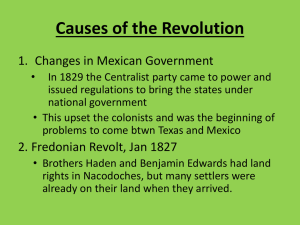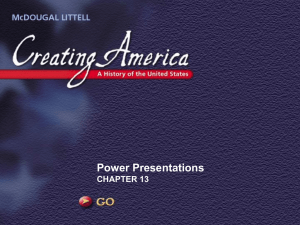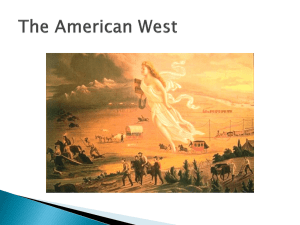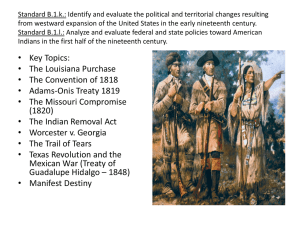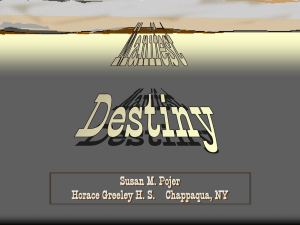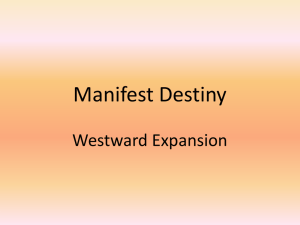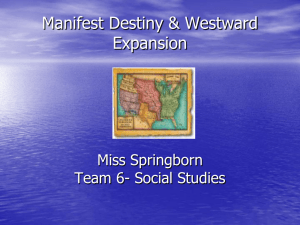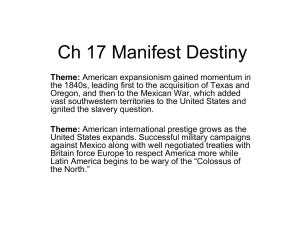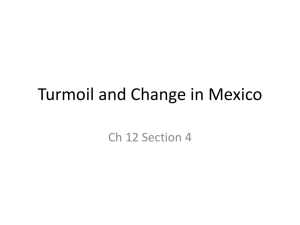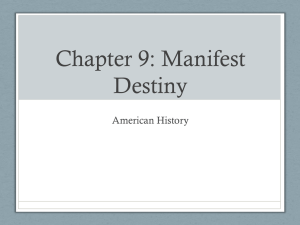Sea to Shining Sea
advertisement
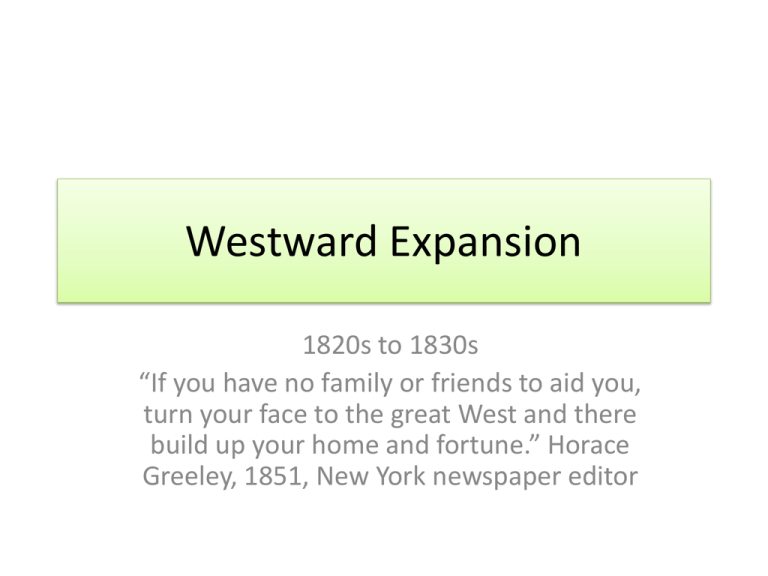
Westward Expansion 1820s to 1830s “If you have no family or friends to aid you, turn your face to the great West and there build up your home and fortune.” Horace Greeley, 1851, New York newspaper editor “It is America's right to stretch from sea to shining sea. Not only do we have a responsibility to our citizens to gain valuable natural resources we also have a responsibility to civilize this beautiful land." May have been John Quincy Adams Was it really America’s Right? British Debate Rules • Two sides of the class. • You get 5 minutes to think about your side of the argument –either for or against Manifest Destiny. • When it is your side’s turn only ONE person can speak. • If you like what they said, pound your fist on your desk. • Only 5 arguments per side. The Oregon Tale “Go West, Young Man!” • Questions 1 – 3 in your packet! • Claims on Oregon: US, Great Britain, Spain and Russia. • US side: We’ve been exploring this area a lot! • Brit side: We’ve had an outpost here longer! • Spanish: No hay muchos españoles aquí... • Russ side: Есть не так много русских здесь ... (Yestʹ ne tak mnogo russkih zdesʹ) **Who do you think the land really belonged to? “Go West, Young Man!” • Mountain men moved to the Far West • In search of beavers and animals with fur--to sell to China for high profits. • Rugged, independent individuals, dangerous lives, lived off the land. “I have held my hands in an anthill until they were covered with ants, then greedily licked them off.” • What qualities helped the mountain men survive in the wilderness? Do you think such qualities are still important today? • Rendezvous –where mountain men and fur traders met to trade fur once a year On the Trail Moving West people traveled on the Oregon Trail: • Why would timing be important? Needed to reach Oregon before October, because of • Life On the Trail • • • • • Dawn: Bugle Blast 6 am: Wagon Ho! Noon: brief lunch 6 pm: make camp, eat dinner, sleep Unloading along the way Symptoms of Cholera • Severe, watery diarrhea – • Diarrhea due to cholera is often voluminous, flecked with mucus and dead cells, and has a pale, milky appearance that resembles water in which rice has been rinsed (rice-water stool). Nausea and vomiting – Occurring in both the early and later stages of cholera, vomiting may persist for hours at a time. • • Muscle cramps. Dehydration – Signs and symptoms of cholera dehydration include irritability, lethargy, sunken eyes, a dry mouth, extreme thirst, dry, shriveled skin that's slow to bounce back when pinched into a fold, little or no urine output, low blood pressure, and an irregular heartbeat (arrhythmia). • Shock. – Hypovolemic shock is one of the most serious complications of cholera dehydration. It occurs when low blood volume causes a drop in blood pressure and a corresponding reduction in the amount of oxygen reaching your tissues. If untreated, severe hypovolemic shock can cause death in a matter of minutes. • Extreme drowsiness or even coma • Fever It could wipe out whole wagon trains because the bacteria is in your poop. Oregon at Last • Despite the hardships, more than 50,000 people reached Oregon between 1840-1860. The Lone Star Story • Questions 4 – 6 in your packet! • Americans in Texas – Texas owned by Spain – Land Grant to Moses Austin 1821 – Mexico gained freedom from Spain – Mexico let Austin bring people in • Settle up land and control Indian attacks – 1830: 20,000 Americans lived in Texas – Mexico wanted Americans to come in to fight off Native Americans and help settle the land. The Lone Star Story • The Republic of Texas – – – – – – – – – – Texans (Americans) become Mexican citizens for land. Over time, they lost loyalty to Mexico Protestant vs. Catholic 1830: You can stay, but No More Americans! Fear U.S. wanted Texas 1833 General Santa Anna--ruled like a dictator and wanted back Texas 1835: “see Texas forever free from Mexican domination” Took San Antonio Declared independence on March 2, 1836 Republic of Texas, Sam Houston commander of Army • Similar to another story? How so? The Alamo • Tremendous odds--150: 6,000 • Retreated to eh Alamo: a Spanish mission-Spanish teaching the Native Americans • Supplies, food and water were low • Davy Crockett--one of the leaders • Siege occurs--military blockade to force them to surrender • Lasted for 12 days • On March 6, the walls of the Alamo come down, swarmed in and killed almost everyone. Revenge and Problems: San Jacinto • Battle San Jacinto – Lasted for 18 minutes – 630 dead, 700 captured – Santa Anna captured and killed. They forced him to sign their independence. – Hooray! Texas is free! – The Lone Star Republic. Flag with one star. Sam Houston President. – Treaty illegitimate? – Sovereign? – Broke! – Would joining the US solve their problems? How did the United States feel? • The U.S. had mixed feelings: – White Southerners Yes! – White Northerners No! – Why? – Pres Jackson worried about war with Mexico – No annexation--ANNEX: to add on. Primary Sources • Look for: – Who wrote this? – What bias might he have? – What was said? – What was the point of the document? • How does this change the way we understand The Lone Star Story? California and the Southwest New Mexico Territory • All owned by Mexico: present-day states of Arizona, New Mexico, Nevada, Utah and California • Southwest: hot and dry. Thick grass in some areas, desert and mountain in others. • First white settlers to the area: merchants and adventurers--sold their cloth and other goods to the Mexicans. • Spanish soldiers and priests also set up missions. – Eventually 21 missions were set up along the California coast Mission Life • California Indians lived in small groups and weren’t able to resist the soldiers who made them work for the missions. • Herded sheep and cattle, and raised crops for the missions. In return, they got to live at the mission and learn about the Roman Catholic religion. • Thousands died from overwork and diseases. • After Mexico won its independence, it got worse. The Mexican government sold mission land to ranchers, who treated the Native Americans even worse. “Even more degrading, and more oppressive than that of our slaves in the South.” • IMPACT: From 1770-1850, population went from 310,000 to 100,000. Expansion: A Right and a Duty • Manifest Destiny: – Manifest: clear or obvious – Destiny: something that is sure to happen ****Believed that the United States was clearly meant to expand to the Pacific--from sea to shining sea. ****Believed they were superior to Native Americans and Mexicans-Racism justified their actions. • James K. Polk runs for President and people elect him because he believes in expansion. Gaining Oregon • Polk fulfilled his promise and when he took office, he moved to gain control of Oregon. • He threatened Britain with war and was offered a compromise: Britain would take everything above 49 degrees North. U.S. got the land south of the line. • Known as the Oregon Territory--Oregon, Washington and Idaho later. Annexing Texas (1845) • Sam Houston--President of Texas, really wanted to be annexed • (added to) the U.S. • Only after pretending to • become allies with Britain, • did America agreed to take • Texas on. • Why would the U.S. not want Texas to join Britain? • How does Mexico feel about this? • They never accepted the independence of Texas to begin with. Also, didn’t want Americans in California and New Mexico to The Mexican War Begins • A border dispute in Texas begins. Both sides are claiming more land. America claims that they own land to the Rio Grande. Mexico claims to own the land to the Nueces River. Both places are on the other’s land. • Who does Polk urge to declare war? • U.S. troops go on to take over San Diego as well. Americans in California excited! By 1847, the U.S. controlled all of New Mexico and California. Meanwhile, General Scott (U.S.) had reached Mexico City (Capital of Mexico) and the Mexicans were forced to surrender and make peace. Treaty of Guadalupe-Hidalgo • In 1848, Mexico signed the treaty that ceded--gave-- all of California and New Mexico (current day California, Nevada, Utah, Arizona, and New Mexico) to the United States. • CEDE: to give • U.S. paid $15 million to Mexico • This lands were called the Mexican Cession Completion of Manifest Destiny • A few years after the War (1853), the U.S. agreed to pay Mexico $10 million for a strip of land in present-day Arizona and New Mexico. • This land was needed to complete the building of a railroad. • Known as the Gadsden Purchase. • The dream of Manifest Destiny was complete! Manifest Destiny- A right? A duty? • Who was affected by America’s belief of Manifest Destiny? • Was it a positive or negative thing? A Rush to the West Mormons and Sutter’s Mill The Mormons • The largest group of settlers to move into the Mexican Cession. • Mormons= Members of The Church of Jesus Christ of Latter-day Saints. A new religion started by Joseph Smith in 1830. • Why move? – They were persecuted and forced to move from many different states. – New York --> Ohio --> Missouri --> Illinois --> Utah – Their new leader, Brigham Young realized they needed to find a home where they could be safe. He had read about the Great Salt Lake in Utah and thought it would make a good home. Prospering in Utah • Because Utah was a harsh desert climate, they had to work hard. • They had an irrigation system to bring water to farms. • Drew up plans for a large city to be built. • In 1850 it was declared a territory and in 1896, it gained statehood. California Gold Rush “It was a clear, cold morning; I shall never forget that morning. As I was taking my usual walk,…my eye was caught with the glimpse of something shining in the bottom of the ditch. There was a bout a foot of water running then. I reached my hand down and picked it up; it made my heart hump, for I was certain it was gold.” - James Marshall Sutter’s Mill • In 1848, John Sutter was building a saw mill on the American River, north of California. • Gold was discovered and in a few days, the word spread to San Francisco, and then on to the rest of the United States. • People from Europe, China, Australia, and South America also joined the rush. • More than 80,000 people came--Known as the FortyNiners. – Only a few actually struck it rich, but everyone stayed in California. • California became a state in 1850. California’s Unique Culture • People from Hawaii, China, Peru, Chile, France, Germany, Italy, Ireland, and Australia • Many white Americans too. • Mexican Americans: Many of them lost land they owned for generations. Still, they fought to preserve their customs. • Native Americans: Driven off their lands and later died of starvation or diseases. Others murdered. In 1850, 100,000 Indians and by 1870, only 17,000. California’s Unique Culture • Chinese Americans: At first welcomed, but then pushed aside when found to be successful. Despite discrimination, they stayed. • African Americans: Some got wealthy fast, but still denied certain rights. Not allowed to testify against whites in court.

